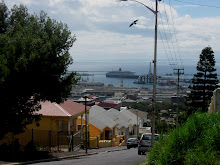 Chalky cuttlebones are a familiar sight on beach high tide lines in South Africa. As a kid I remember collecting them for my budgies. They are the internal skeletons of cuttlefish, members of the Cephalopodia (a Greek word meaning "head feet") class of mollusc that include squid, octopuses and cuttlefish -certainly the most sophisticated invertebrates around today. Their ancestors used to dominate the waters of the prehistoric ocean - everyone has heard of ammonites and belemnites; and there is even a legendary kraken.
Chalky cuttlebones are a familiar sight on beach high tide lines in South Africa. As a kid I remember collecting them for my budgies. They are the internal skeletons of cuttlefish, members of the Cephalopodia (a Greek word meaning "head feet") class of mollusc that include squid, octopuses and cuttlefish -certainly the most sophisticated invertebrates around today. Their ancestors used to dominate the waters of the prehistoric ocean - everyone has heard of ammonites and belemnites; and there is even a legendary kraken.My find this morning on Fish Hoek beach is probably the cuttlebone of Sepia papillata - a large cuttlefish (15 cm long) that occurs in the open ocean off southern Africa. The cuttlebone is used to regulate the buoyancy of the cuttlefish by modifying its gas and liquid content.
Cuttlefish are also famous for producing the familiar sepia pigment used in ink.
Information from Two Oceans: A guide to the marine life of southern Africa by George Branch et al.



 Cape Town Time
Cape Town Time

































We always collected them for our birds as well.
ReplyDelete